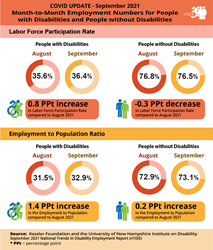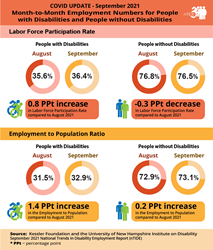
nTIDE Month-to-Month Employment Numbers for People with and without Disabilities
“For the second consecutive month, we have seen improvement in the employment-to-population ratio for people with disabilities,” said John O’Neill, PhD. “This bright spot shows continued resilience among people with disabilities in the labor market.”
EAST HANOVER, N.J. (PRWEB)
October 10, 2021
Job numbers improved for people with disabilities, whose engagement with the labor market surpassed their pre-COVID-19 pandemic levels, according to today’s National Trends in Disability Employment – Monthly Update (nTIDE), issued by Kessler Foundation and the University of New Hampshire’s Institute on Disability (UNH-IOD). Their gains contrast with those of people without disabilities, whose job numbers have yet to reach pre-pandemic levels.
nTIDE COVID Update (month-to-month comparison)
In the Bureau of Labor Statistics (BLS) Jobs Report released Friday, the labor force participation rate for working-age people with disabilities increased from 35.6 percent in August 2021 to 36.4 percent in September 2021 (up 2.2 percent or 0.8 percentage points). For working-age people without disabilities, the labor force participation rate decreased from 76.8 percent in August to 76.5 percent in September 2021 (down 0.4 percent or 0.3 percentage points). The labor force participation rate is the percentage of the population that is working, not working and on temporary layoff, or not working and actively looking for work.
“People with disabilities appear to be recovering faster than people without disabilities. In fact, their labor market engagement is now surpassing their pre-Pandemic levels,” emphasized Andrew Houtenville, PhD, professor of economics and the research director of the University of New Hampshire’s Institute on Disability. “This is very good news!”
The employment-to-population ratio for working-age people with disabilities increased from 31.5 percent in August 2021 to 32.9 percent in September 2021 (up 4.4 percent or 1.4 percentage points). For working-age people without disabilities, the employment-to-population ratio increased, albeit slightly, from 72.9 percent in August 2021 to 73.1 percent in September 2021 (up 0.3 percent or 0.2 percentage points). The employment-to-population ratio, a key indicator, reflects the percentage of people who are working relative to the total population (the number of people working divided by the number of people in the total population multiplied by 100).
“For the second consecutive month, we have seen improvement in the employment-to-population ratio for people with disabilities,” said John O’Neill, PhD, director of the Center for Employment and Disability Research at Kessler Foundation. “This bright spot shows continued resilience among people with disabilities in the labor market,” he added. “If the COVID Delta variant wanes and vaccination rates increase, we may continue to see improvement.”
Year-to-Year nTIDE Numbers (comparison to the same time last year)
The employment-to-population ratio for working-age people with disabilities increased from 28.3 percent in September 2020 to 32.9 percent in September 2021 (up 16.3 percent or 4.6 percentage points). For working-age people without disabilities, the employment-to-population ratio also increased from 70.0 percent in September 2020 to 73.1 percent in September 2021 (up 4.4 percent or 3.1 percentage points).
The labor force participation rate for working-age people with disabilities increased from 32.7 percent in September 2020 to 36.4 percent in September 2021 (up 11.3 percent or 3.7 percentage points). For working-age people without disabilities, the labor force participation rate also increased from 75.7 percent in September 2020 to 76.5 percent in September 2021 (up 1.1 percent or 0.8 percentage points).
In September 2021, among workers ages 16-64, the 5,244,000 workers with disabilities represented 3.7 percent of the total 143,536,000 workers in the U.S.
nTIDE COVID Update – Friday, October 22, 2021 at 12:00 pm Eastern
Stay tuned for our mid-month update about the employment of people with disabilities as we follow the impact of COVID-19 and look at the numbers in more detail.
NOTE: The statistics in the nTIDE are based on Bureau of Labor Statistics numbers but are not identical. They are customized by UNH to combine the statistics for men and women of working age (16 to 64). nTIDE is funded, in part, by grants from the National Institute on Disability, Independent Living and Rehabilitation Research (NIDILRR) (90RT5037) and Kessler Foundation.
About Kessler Foundation
Kessler Foundation, a major nonprofit organization in the field of disability, is a global leader in rehabilitation research that seeks to improve cognition, mobility, and long-term outcomes — including employment — for people with neurological disabilities caused by diseases and injuries of the brain and spinal cord. Kessler Foundation leads the nation in funding innovative programs that expand opportunities for employment for people with disabilities. For more information, visit KesslerFoundation.org.
About the Institute on Disability at the University of New Hampshire
The Institute on Disability (IOD) at the University of New Hampshire (UNH) was established in 1987 to provide a coherent university-based focus for the improvement of knowledge, policies, and practices related to the lives of persons with disabilities and their families. For information on the NIDILRR-funded Employment Policy and Measurement Rehabilitation Research and Training Center, visit ResearchOnDisability.org.
For more information, or to interview an expert, contact:
Carolann Murphy, CMurphy@KesslerFoundation.org.
Share article on social media or email:

